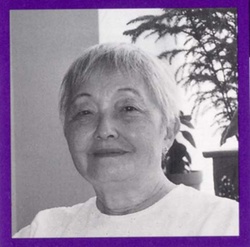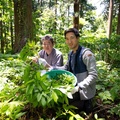Chiye Tomihiro is used to being interviewed. She testified before the Commission of Citizens (CWRIC) in 1981, her memories are in several oral history collections, and she has appeared on TV and in magazine stories. Her grace reflects both her experience and her nature. Poised and at ease, she offers cold drinks to visitors in her lakefront Chicago apartment.
She wastes no time. “I was born in Portland, Oregon, in 1924. The first thing that I mention to people from California is that there were only about a hundred families in Oregon. We were really a minority in our schools. We were made to feel more conscious of our background, because we weren’t as secure.” Though she says that there wasn’t much prejudice in Oregon as in California, she remembers that the Yasui family, in Hood River, “really were subjected to a great deal of discrimination after the war started…it was all economic, of course, because Mr. Yasui was so successful.”
Tomihiro’s parents both came from Hiroshima; her father in 1903. He studied at a Language Institute in Tokyo, and spoke and wrote English when he arrived in Hawai‘i. He had planned to be a doctor, “but he worked on a plantation for six months treating machete injuries and that changed his mind,” she remembers. He traveled on to San Francisco, worked as a “houseboy” and went on to high school. After the San Francisco earthquake in 1906, he moved to Portland.
Tomihiro’s father went back to Japan at the end of 1923, just before the Japanese exclusion act went into effect, to marry and bring his new wife back to Oregon. He was forty years old. “I’m the only child,” Tomohiro says, “and I never married.” Then she moves into the heart of her story.
Her father was picked up on December 7, 1941, and sent to a Justice Department internment camp. “They moved him around so much,” Tomihiro recalls. “He was in Missoula, Montana, then he was in Camp Livingston, Louisiana, but he finally ended up in Santa Fe.” When the evacuation orders came, she and her mother had to pack up the hotel that the family owned, and ready themselves for camp. She remembers that they were helped by the hotel manager and friendly tenants, and that a hotel clerk cared for their possessions and sent them on to them after the family reached Chicago. “There were some good decent people,” she says.
“Min Yasui drove us to the assembly center. You know about Min, don’t you? He’s the one that tested the constitutionality of the curfew. I’m the one that called the police for him,” she remembers. “He decided that he would walk the street because he wasn’t supposed to be out after eight o’clock, and he told me to call the police and say that there was a Jap walking down the street. So I called and the police didn’t pay any attention to me… He became very discouraged, and said ‘I guess I’ll just have to walk in and give myself up,’ so he took a carton of cigarettes and a newspaper and walked into the Multnomah County jail. That’s how he got arrested.” Yasui was released, and after he drove Chiye and her mother to Hood River and “waited for the marshals to pick him up,” she says. Yasui’s case became one of four test cases that made it to the Supreme Court, which upheld his conviction. (In 1984, Yasui’s conviction was vacated.)
“I was supposed to graduate from high school in June of ’42, and we were evacuated in May, so it was one month before we graduated. I did some book reports or something and sent me my diploma later on,” Tomihiro remembers. Mother and daughter were sent to Minidoka in Idaho, but Chiye soon left camp to attend Denver University. Mrs. Yasui and three of her children were in Denver and “we were very good family friends and my mother felt more secure about sending me someplace where we knew people,” Tomihiro says. Her mother and father were not reunited until April 1944, when he was finally released from Santa Fe to Minidoka.
Tomihiro visited Minidoka to see her parents, then transferred to the University of Wisconsin. “At that time I thought I was going to study journalism. I ended up majoring in math and minoring in business administration,” she remembers. “My folks moved to Chicago in October 1945 when the camps closed, and after I graduated I just moved to Chicago and joined them.”
Of her early experience in Chicago, Tomihiro recalls, “People were mostly ignorant. They really didn't know about evacuation and they would say ‘Where are you from?,’ and you’d say Portland, Oregon” and they wanted you to say ‘China’ or ‘Japan.’ But I could not tell them I had been in a camp. I shouldn’t have been ashamed but I was. The words stuck in my throat, I just couldn’t say that. They’d say ‘why are you here?’ and I’d make up some kind of story…
“That’s the kind of thing that we all suppress…the hurt, the anger. The fear and the guilt. The thing I always recall about the assembly center was when classmates came to visit me. We were only ten miles away so it was very easy for them to come to visit, and here you were, standing behind barbed wire talking to your friends. It was really embarrassing, humiliating. I mean you felt like a criminal. But even something like that, I had suppressed. It really didn’t come out until the Commission Hearings.”
Tomihiro recalls the 1981 CWRIC (Commission on Wartime Relocation and Internment on Civilians) hearings as “a turning point in my life. Until that time I was denying that anything had happened.” Although she had been active in the Japanese American Citizens League (JACL) since the early ’50s, she remembers that she was not “too concerned about politics, civil rights, things like that. We were so busy trying to get back on our own two feet that these things were not of interest to us.”
Asked about settling in Chicago, Tomihiro remembers, “The thing that was the most difficult for people when they resettled here was housing. Because there was a severe housing shortage due to the war, [and] there was a lot of discrimination. We couldn’t live where we wanted to live—there was also discrimination in some of the restaurants. I remember that I went in a restaurant with all of my friends, they were white, and they turned us away because I was in the group.” Her mother worked as a seamstress and her father looked for work. “This is what I testified about at the Commission hearings,” Tomihiro says, “about how our parents lost everything. By the time they relocated here in Chicago, my father was 60 years old and he had always been a white collar worker, he graduated law school but couldn’t practice law because he was not a citizen, so he naturally wasn’t really up to doing manual labor.”
Tomihiro remembers that it was also hard for her to find a job in Chicago at first. She recalls that even white women had trouble finding work in some fields at the time, but she eventually got a job as an assistant payroll supervisor and was soon promoted to office supervisor. Then she worked at the Arts Club of Chicago, “a wonderful job,” she reports, where “I learned a lot about art and music—it really opened windows for me.” She stayed for eighteen years as office manager and bookkeeper.
After a year with a large lumber company, a friend begged her to help out a mutual friend, a surgeon, whose 72 year old secretary was ready to retire but was having trouble letting go. Tomihiro demurred. “I said ‘No, I’m not a secretary and besides I know nothing about medicine or medical terms or anything like that,’ and he said, ‘Well just go and work with her awhile,’ so I did and she got the hint, she decided to retire.” Tomihiro maintains that she “can’t type worth a darn,” but soon discovered that what the doctor really needed was someone to manage his personal finances. “He was one of these people who had absolutely no sense of money at all,” she says, and she stayed with him from 1969 until his death in 1981. The doctor made Tomihiro trustee of his estate, so “you could say I’ve been working for him for the past 16 years too.”
Of her career as an ikebana teacher, Tomihiro remembers that she began her Japanese flower arranging study with the wife of a Buddhist priest in 1955. She studied with Mrs. Arakawa for 28 years. “People always say how can you study one thing for 28 years, but that’s the way it is with ikebana—every flower and every branch has a personality of its own,” she says.
“The welfare of my community has always been a big motivating factor for me,” she says. “I came by it naturally because my father was very active in the community. He was very active in Portland, that’s why he was interned. And after he came to Chicago he was very active too. He was one of the founding members of the Chicago Shimpo, active in the Mutual Aid Society. I always admired my father for what he did, he gave a lot and his fluent English, he would go to court with people… He gave so much of his time that he never bought any fruit, he never bought any vegetables, we never bought any rice. People always brought us stuff like that. The only things we bought were meat and chicken… My father was involved in so many people’s lives.
“At the time of evacuation, somebody had sent us a crate of celery and my mother sent some of it to some neighbors and wrapped it up in paper and the police stopped me because they thought I had a rifle… These are real things that happened. You remember those things.”
Winding up, Tomihiro tells her guest, “One thing that I really want to emphasize is that Chicago has been very kind to us. Those of us who stayed, we stayed because Chicago has been a very good city for us—and of course, we had nothing to go back to. I think a lot of Californians went back because they couldn’t stand our weather!”
*This article was originally published in the Japanese American National Museum Quarterly, Winter 1998-99.
© 1998 Japanese American National Museum







